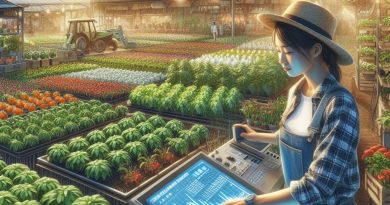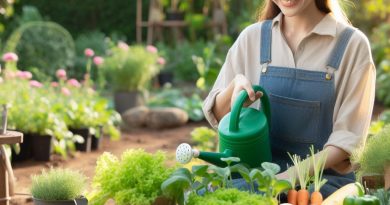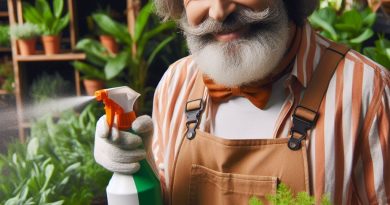DIY Compost Bins: Cheap and Effective Designs
Last Updated on February 8, 2024
Introduction
Importance of Composting
Composting is vital for reducing waste and enriching soil.
It diverts organic matter from landfills, lessening environmental impact.
Composting at home reduces methane emissions, a potent greenhouse gas.
It’s an eco-friendly way to dispose of kitchen and yard waste.
Composting fosters a sustainable lifestyle, promoting environmental stewardship.
Benefits of DIY Compost Bins
DIY compost bins offer cost-effective solutions for waste management.
They utilize readily available materials, reducing expenses.
DIY bins can be customized to fit various space constraints.
Building your compost bin provides a sense of accomplishment.
DIY bins empower you to control the composting process.
These bins encourage creativity and innovation in waste management.
They foster a deeper connection to the composting process.
DIY composting fosters self-sufficiency and reduces reliance on external services.
By making your bin, you tailor it to your specific needs.
DIY compost bins offer a hands-on approach to sustainability.
In summary, composting is crucial for waste reduction and soil health.
DIY compost bins provide numerous benefits, from cost savings to customization.
In the following sections, we’ll explore different designs for creating your compost bin.
Factors to Consider Before Building a DIY Compost Bin
A DIY compost bin can be a great addition to any garden, providing you with rich, nutrient-filled soil for your plants.
However, before you start building, there are several factors you need to consider to ensure its effectiveness.
Here are some key factors to keep in mind:
- Available space: The first thing to consider is the available space in your garden or backyard. Compost bins come in various sizes, so assess your space and choose a bin that fits well.
- Type of composting method preferred: There are different methods of composting, such as aerobic and anaerobic. Consider which method you prefer and choose a design that aligns with it.
- Climate and weather conditions: Climate plays a significant role in the composting process. If you live in a hot and dry climate, you may need a bin that retains moisture. On the other hand, if you live in a cold climate, you might need insulation to keep the compost warm.
- Raw materials and waste generated: Assess the type and amount of waste you generate regularly. If you have a large household or generate a lot of waste, you may need a bigger bin or multiple bins.
Considering these factors before building a DIY compost bin will ensure that you choose the most suitable design for your needs and maximize the benefits of composting.
Read: Herbal Mixes to Protect Your Plants
Types of DIY Compost Bins
Pallet Compost Bin
- Materials needed for a pallet compost bin are a wooden pallet, wire mesh, and zip ties.
- To construct a pallet compost bin, start by attaching the wire mesh to the sides of the pallet using zip ties.
- Pros of a pallet compost bin include its affordability and the availability of free pallets.
- Cons of a pallet compost bin are that it may not be as aesthetically pleasing and can be less durable.
- To achieve success with a pallet compost bin, make sure to turn and mix the compost regularly.
Wire Mesh Compost Bin
- Materials needed for a wire mesh compost bin are a roll of wire mesh, metal stakes, and wire cutters.
- Start the construction of a wire mesh compost bin by forming the wire mesh into a cylindrical shape and securing it with metal stakes.
- One advantage of a wire mesh compost bin is its good airflow, allowing for efficient decomposition.
- A potential drawback of a wire mesh compost bin is that pests can easily access the compost.
- For successful composting with a wire mesh bin, layer carbon-rich and nitrogen-rich materials properly.
Wooden Box Compost Bin
- Materials needed for a wooden box compost bin are wooden boards, screws, and a saw.
- To construct a wooden box compost bin, cut the wooden boards into desired lengths and assemble them using screws.
- A wooden box compost bin provides a neat and organized look and can last for a long time.
- The cost of building a wooden box compost bin may be higher compared to other DIY options.
- To ensure success with a wooden box compost bin, maintain the right moisture level and regularly add organic matter.
Choosing the right compost bin depends on individual preferences and available resources.
Pallet compost bins are great for those on a tight budget, while wire mesh compost bins offer better airflow.
For a more visually appealing option, a wooden box compost bin is the way to go.
Whichever type you choose, remember to turn the compost regularly, monitor moisture levels, and maintain a good balance between carbon-rich and nitrogen-rich materials.
With a DIY compost bin, you can contribute to reducing waste and create nutrient-rich soil for your garden.
Read: Soil Health for Pest/Disease Control
Maintenance and Care for DIY Compost Bins
A well-maintained compost bin is crucial for the success of your composting efforts.
By properly caring for your DIY compost bin, you can ensure efficient decomposition and nutrient-rich compost for your garden.
Here are the essential tasks to keep in mind:
Adding the right mixture of green and brown materials
- Add a balance of green and brown materials to your compost bin for optimal decomposition.
- Green materials include fresh grass clippings, kitchen scraps, and plant trimmings.
- Brown materials include dry leaves, twigs, newspaper, and cardboard.
- The ideal ratio is 3 parts brown to 1 part green, maintaining moisture and promoting microbial activity.
Turning and aerating the compost
- Regularly turn and aerate the compost to introduce oxygen and speed up the breakdown process.
- Using a garden fork or compost aerator, mix the materials to prevent matting and improve circulation.
- Aerate the compost at least once a week to avoid unpleasant odors and enhance decomposition.
Moisture control
- Maintain proper moisture levels in the compost bin for efficient decomposition.
- The ideal moisture range is between 40% and 60%, similar to a damp sponge.
- Add water if the compost appears dry or cover it with a tarp if it’s too wet.
- Regularly monitor moisture levels and adjust accordingly to prevent compaction or excessive drying.
Managing pests and odors
- Prevent pests and odors from becoming a nuisance in your compost bin.
- Avoid adding meat, dairy, oily food, or pet waste, as they attract pests and cause unpleasant smells.
- Layer food scraps with brown materials and cover them to deter flies, rodents, and other unwanted critters.
- If odors persist, mix in more brown materials and ensure proper aeration and moisture control.
By following these maintenance and care practices, you can create a thriving compost bin that produces nutrient-rich compost for your gardening needs.
Remember that patience is key, as composting takes time.
With consistent effort and attention, you’ll soon reap the benefits of your sustainable DIY composting system!
Read: Preventing Garden Pests Naturally

Troubleshooting Common Issues with DIY Compost Bins
Composting is a natural process, but sometimes issues can arise that may hinder the decomposition process or result in unpleasant odors and unwanted pests.
Slow Decomposition
- Ensure the carbon-to-nitrogen ratio is balanced in your compost pile.
- Shred or chop larger materials to speed up the decomposition process.
- Add materials high in nitrogen, such as fresh grass clippings or kitchen scraps.
- Turn the compost pile regularly to aerate it and promote decomposition.
- Avoid adding materials that are slow to decompose, like meat, dairy, or oils.
Foul Smells
- Avoid adding materials that are prone to emitting strong odors, such as meat or dairy products.
- Ensure the compost pile is properly aerated to prevent anaerobic conditions.
- Add dry materials, like leaves or sawdust, to absorb excess moisture and reduce odors.
- Turn the compost pile regularly to promote proper airflow and mitigate foul smells.
- Avoid overwatering the compost pile, as excessive moisture can lead to anaerobic conditions and odor issues.
Attracting Unwanted Pests
- Avoid adding food scraps that may attract pests, like meat, dairy, or greasy foods.
- Bury food scraps deep within the compost pile to discourage pests from accessing them.
- Consider using a rodent-proof compost bin or secure the compost pile with wire mesh.
- Avoid adding yard waste that may harbor pests or their eggs, like grass clippings containing ticks.
- Regularly inspect the compost pile for signs of pests and take necessary measures to eliminate them.
Excessive Moisture or Dryness
- Monitor the moisture level of your compost pile regularly.
- If the pile is too dry, add water gradually while turning the compost to distribute moisture evenly.
- Avoid overwatering the compost pile, as excessive moisture can lead to odor issues and anaerobic conditions.
- Add dry materials like straw, sawdust, or shredded newspaper to absorb excess moisture.
- Provide shade or cover the compost pile during heavy rainfall to prevent excessive moisture accumulation.
By troubleshooting common issues with DIY compost bins, you can ensure a successful composting process and enjoy the benefits of nutrient-rich compost for your garden.
Read: Fighting Fungi: Organic Methods
Harvesting and Using Compost
Signs of completed compost
- Dark, crumbly texture indicates decomposition completion.
- Earthy smell demonstrates that organic material has broken down.
- Absence of recognizable materials like twigs or leaves suggests compost is ready.
Harvesting techniques
- Start by stopping any addition of new materials a few weeks before harvest.
- Use a compost screen or simply sift through the compost using a pitchfork.
- Collect the finished compost, leaving any unfinished materials for further decomposition.
Using compost in gardens and potted plants:
- Mix compost with soil for gardens before planting to improve nutrient content.
- Apply a layer of compost as a mulch to reduce weed growth and retain moisture.
- For potted plants, blend compost with potting soil to enhance plant health and growth.
Benefits of using homemade compost
- Improved soil structure: Compost helps increase the water-holding capacity and aeration of soil.
- Nutrient-rich soil: Homemade compost provides a natural source of essential nutrients for plants.
- Increased plant resistance: Compost enhances plants’ ability to resist diseases and pests.
- Environmental sustainability: Composting reduces waste sent to landfills and promotes recycling.
- Cost-effective: Making compost at home saves money on buying commercial fertilizers or soil amendments.
- Reduces reliance on synthetic chemicals: Compost reduces the need for chemical fertilizers, promoting healthier ecosystems.
In fact, harvesting and using compost offers numerous benefits for gardeners and plant enthusiasts.
Recognizing signs of completed compost, such as its texture and smell, is essential for efficient harvest.
By employing techniques like using a compost screen or manually sifting through, one can separate the finished compost from unfinished materials.
Incorporating this nutrient-rich compost into gardens and potted plants promotes healthy growth and improves soil quality.
The advantages of homemade compost range from improving soil structure to reducing reliance on synthetic chemicals, making it an environmentally-friendly and cost-effective choice.
Start composting today and reap the rewards of this natural and sustainable resource.
Conclusion
Recap of DIY compost bin options
When it comes to DIY compost bins, there are various options to choose from.
You can repurpose old containers, build wooden structures, or simply use a large plastic container.
Each option has its advantages and can be tailored to suit your needs.
Encouragement to start composting
Composting is not only an eco-friendly way to manage organic waste but also a cost-effective solution.
By composting at home, you can reduce landfill waste, create nutrient-rich soil, and contribute to a healthier environment.
So why not give it a try?
Final thoughts and tips
Remember to add a balance of green and brown materials to your compost pile, keep it moist but not overly wet, and turn it regularly to promote decomposition.
Don’t be afraid to experiment and adjust your composting method to achieve the best results.
In closing, DIY compost bins provide cheap and effective solutions for managing organic waste.
Whether you choose a simple or elaborate design, starting to compost at home is a positive step towards a more sustainable future.


